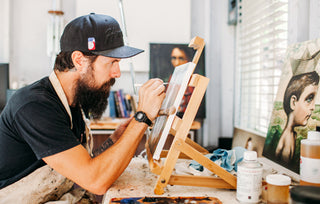“I’ve been taking my poetry with me,” our friend and artist Richard J Oliver tells us. We had driven up into the mountains of West Hills, California, to talk to the Welsh artist at his home in the carved rock of the canyon. “There was a run that I was doing and [thinking] of the poem by Solomon. The first line was ‘You split my heart in two and filled me with love.’ And I broke down. I literally stopped. I was standing on this trail sobbing at these words… about the way life breaks through the Earth to produce through the seeds. And that life is flowing from the deepest part of the ocean, the flow of the currents there to the pulse in our blood… I was just surrendering to my environment and to this beauty of life. And then I suddenly got sucked into a void of loneliness. It was just such a play.”
Following Richard’s “This Too Shall Pass” exhibit at Known Gallery, his newest show opens this Saturday at Last Rites Gallery in New York City. The exhibit is called “Elements” and all of the pieces in the show are named after quotes from the Sufi mystic and poet Rumi. The idea for it came to him during what he calls a walkabout, in which he says to his family, “Thank you so much for understanding me. I’ve got to go away from everything,” packs his bags, and begins to hike into the mountains near his home. This particular epiphanic walkabout occurred after a personal and spiritual transition in the themes of his work, he says, “I discovered that I could actually use this show [“Elements”] as a way of purging things that no longer served me.”
Bobby Hundreds has said that Richard is one of his favorite artists for not only his technique and style, but for the depth of thought and narrative in his paintings. “It’s that intellectual capacity that sets Richard J Oliver apart,” says Bobby. In the interview below, we discuss how living in LA has impacted his work, the giants we carry with us day-to-day, the simultaneous need for home and away, and seeing death as a way to shine light on life.
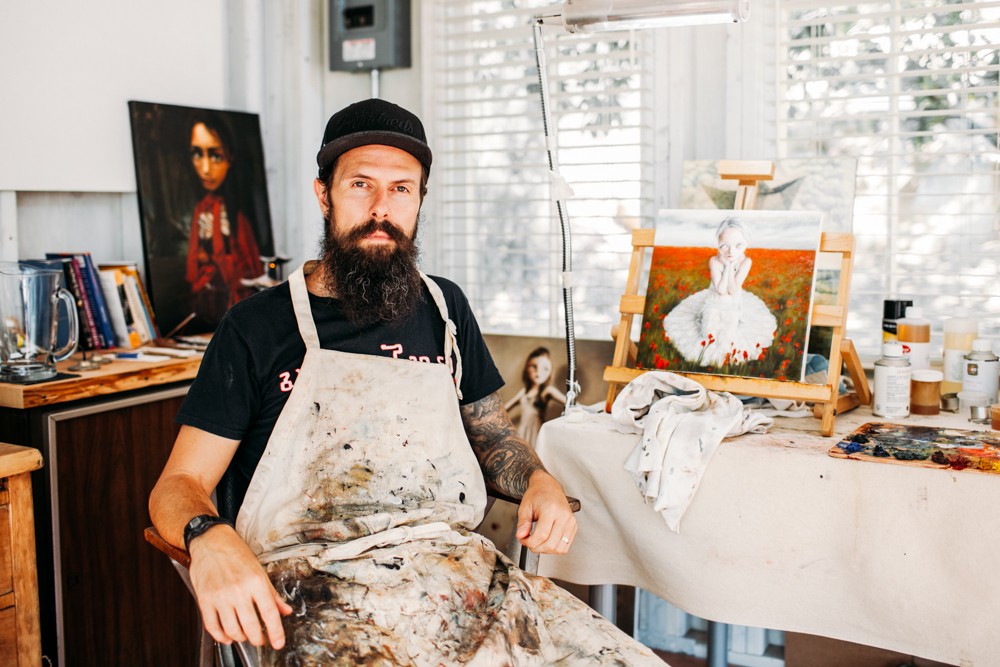
I read that for your last show “This Too Shall Pass” that the works were about survival and struggle. Can you tell us about what the works in your upcoming show “Elements” will be about?
It was a bit of a difficult show because I went though a transition last year as I was working towards my non-gallery show. My first shot at non-gallery was a period where I was a new dad and I was struggling with the ideas of survival, the impotence of being a parent trying to protect my children in a world that’s going to shit. And I was painting apocalyptic paintings with kids trying to survive with found weapons in some sort of post-war situation because nobody wants to see children with weapons—it’s the most tragic thing. That’s what I was dealing with.
But I went through a personal and somewhat spiritual transition where I discovered I didn’t really want to fill my mind and space with negative things. I discovered I was actually fueling the things I was fighting against by fighting them. So I opted for more of an affirmation kind of route where I was choosing its opposite and celebrating its opposite to lead peoples’ attention away from what was negative. It was more celebration of life and beauty rather than a fight to the ugly, if you know what I mean.
When did you hit a turning point?
I stumbled across something that really worked for me, it was actually during a sweat lodge. One of my neighbors has an authentic sweat lodge and I started attending that. There’s a process, the third process of the sweat actually focuses on death—but not death in a negative way—it’s getting rid of things that no longer serve you. So it’s almost like a purge and it was very intense.
When I kind of lost my mind, I went on a hike. I didn’t know what I was going to do creatively for this show. Went on a hike and the idea of Last Rites and this process that I experienced during the sweat came together in somewhat of an epiphany. I discovered that I could actually use this show as a way of purging things that no longer served me. So still producing positive works and still producing works with hope, survival, continuity, and celebrating life but in ways of showing and getting rid of things that don’t serve me anymore.
So it’s using death to shine a light on life. So that was really my intention. Images of the phoenix come to mind. Rebirth.
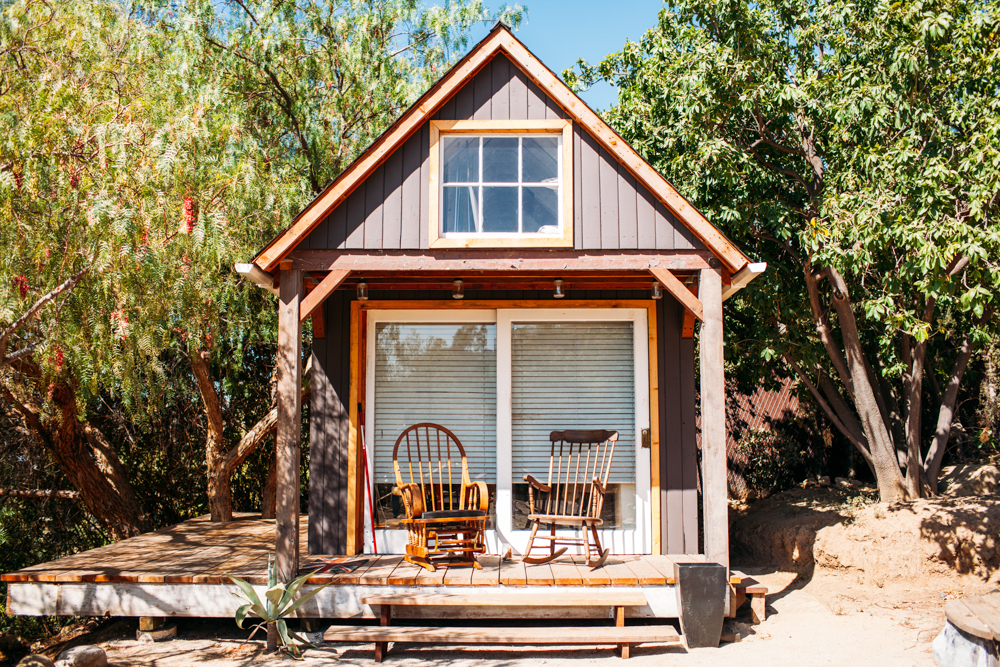
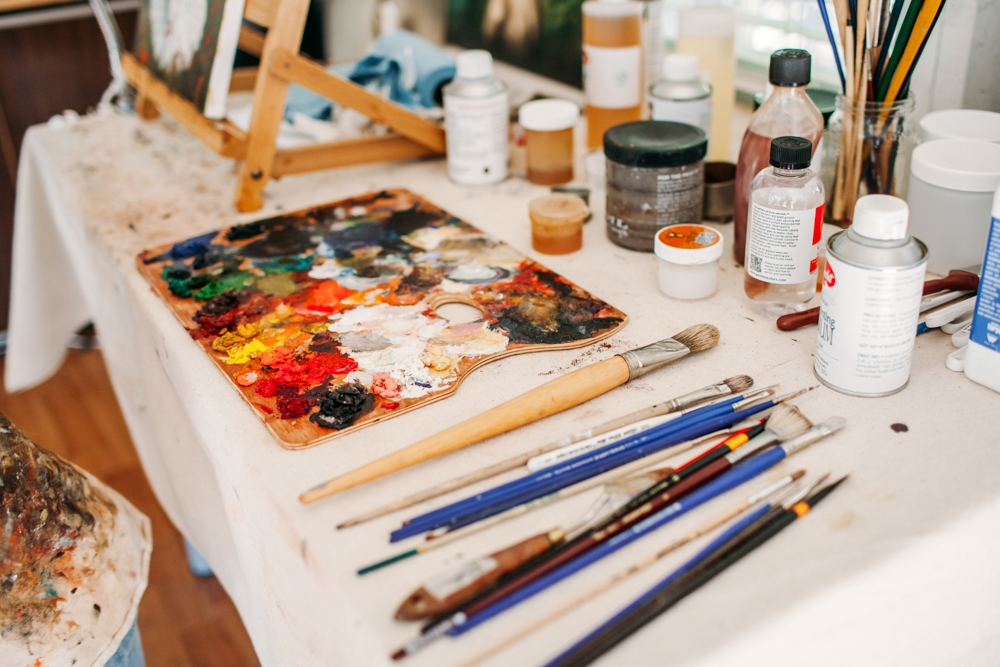
A shedding off of the old?
Yes, and using it as almost a therapy, not celebrating the dark but using it just to show the light after potentially dark elements. So one of the first paintings I did was called “Fire” and it’s a picture of a boy. The person who actually modeled for me had a personal tragedy and had a phoenix tattooed on his chest. The whole idea is that the rebirth is the survival and the continuity of life even after tragedy.
…After the Known Gallery show I kind of lost my way a little bit. I was exhausted. It was an intense period of painting, so I went for a walkabout. I often go on these walkabouts where I say to my wife, “Thank you so much for understanding me. I’ve got to [get] away from everything.” It’s almost like silence. I’ve got to reach into the silence in order to get clarity. And the idea of “Elements“ came to me from a walkabout. Sounds romantic right? It’s a struggle. [laughs]
What is a walkabout? Does that just mean you kind of go?
I just pack my bag and I hike and walk.
How long do you usually do that for?
I can go for a week or so, or a day. I run every morning, I try to run every day. It’s become my meditation, it’s the only way that I can burn off excess energy and get to a place of clarity.
It’s silly because hopefully I develop my practice so I don’t actually have to go away somewhere physically. Because often as soon as I’m away I realize I don’t need to be away to do this. But when I’m in a funk and just can’t get on top of it, I’ve just got to walk. Yesterday, I considered them big problems, today I realized through my run that they were just circumstances. It brings so much clarity to me. I can just deal with them a lot better and I don’t see them as problems, just situations.
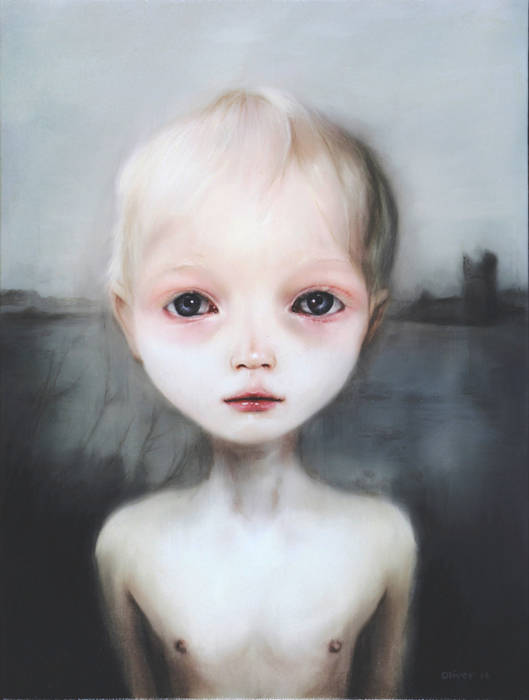
My place is placeless, a trace of the traceless, 2014. Oil on canvas.
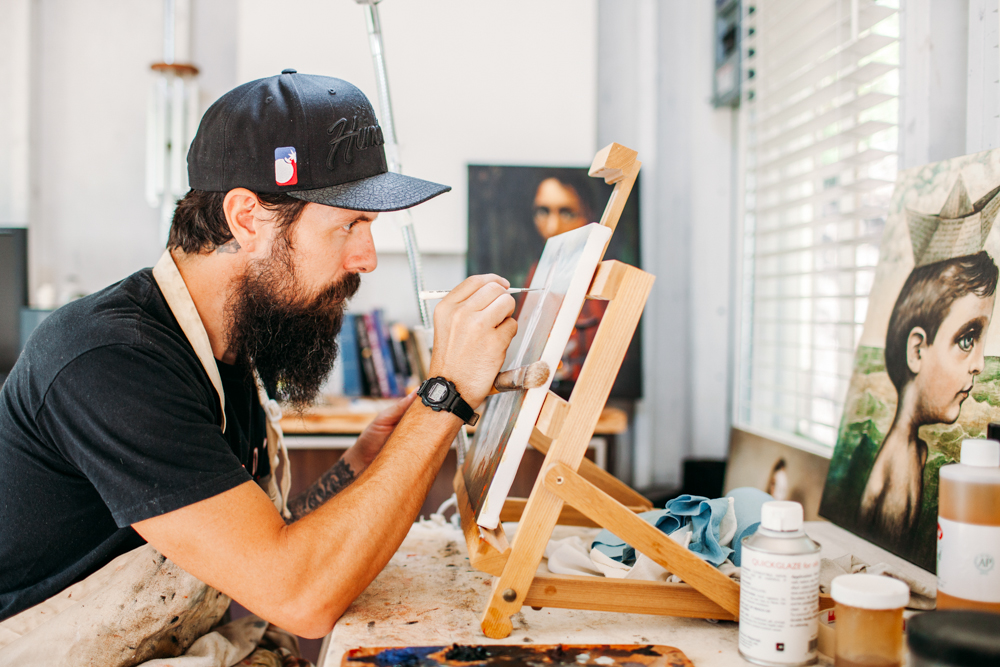
Sometimes you just have to get away enough. It makes sense as to why you had to build this studio just to be away a little bit.
Yeah, I think the first that happens when I go away is I realize that I don’t go away. I’m into poetry at the moment, which is weird for me because I’ve hated it all my life and suddenly it was just like, gasp! This is incredible! But I was reading a poem… it’s a great visual, I can’t remember it word for word, but it kind of says, “When I’m at home, I’m terribly bored, when I go to Rome I find myself yearning home, and with God I’m terribly bored, but when he leaves my sight I’m terrified.” I’ve always [visualized] that it doesn’t matter where in the world I go if I’m towing my giant with me, which is this big guy standing on my shoulder going, “Everything is shit.” I can be in the most fantastic places and have the same problems.
I say to my son all the time, he’s like, “Where are we?” And I say, “We’re here, we’re always only ever here, we can never be anywhere else.” So when I say “away” it’s a vessel for me to actually come back home, metaphorically. [laughs]
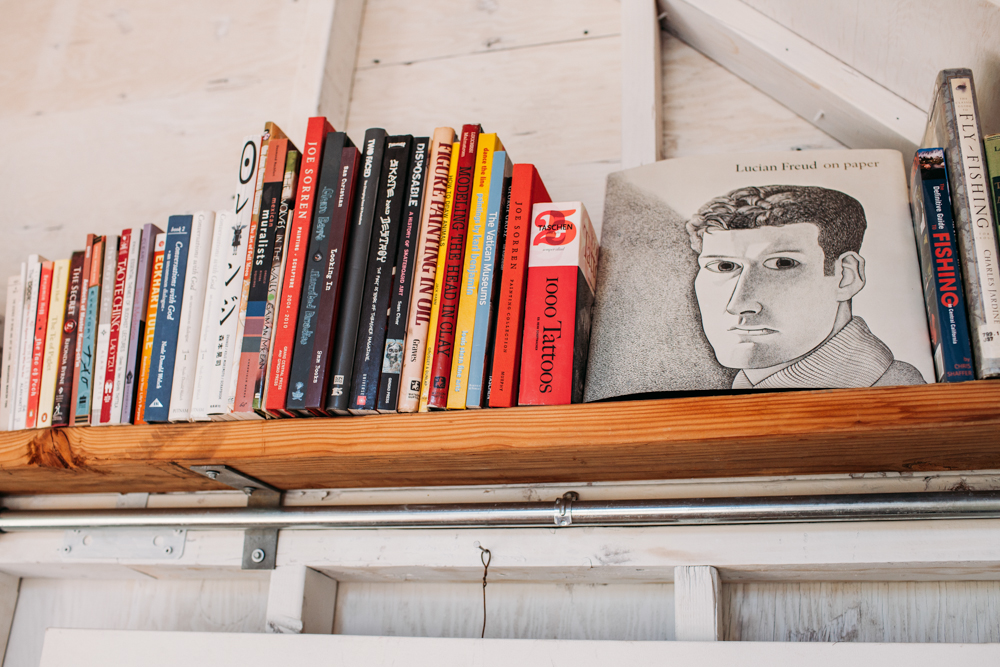
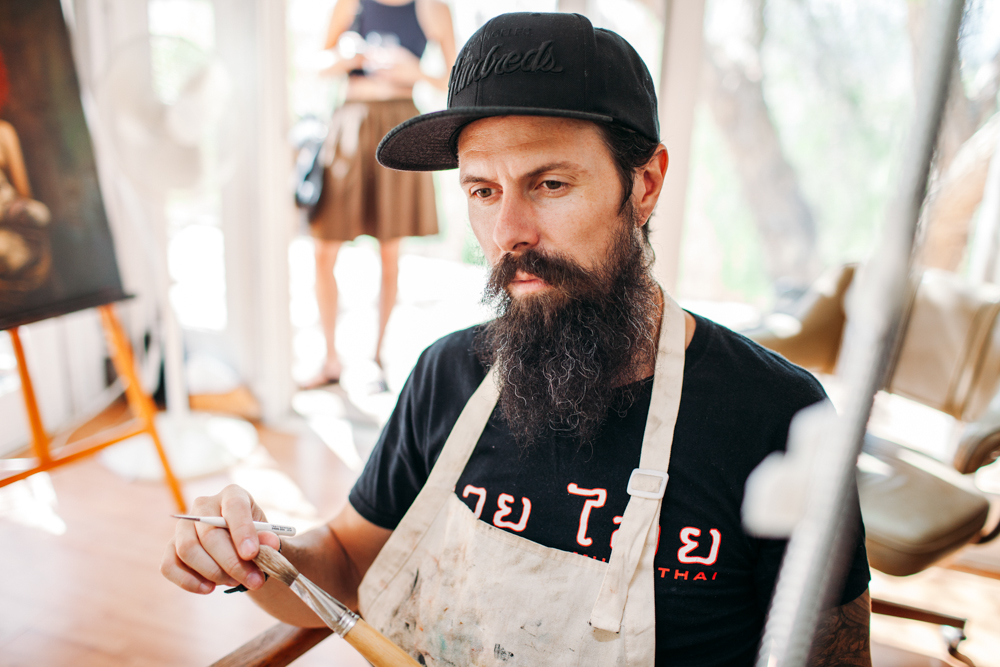
I was reading about you, your move to LA, and it seems like you’re really sensitive to environments and things around you. For instance when you moved to LA your art had a lot more displacement in your themes. Can you tell us more about that?
It’s right, what you say. I’ve grown in Wales for most of my life. I left there when I was 28 or 30, that’s all I really knew. Identity was difficult over there because there was a big void left over from when we were a self-sufficient country. So that really encompassed most, if not all of my work. There was this play of outer-placeness, the identity of the kids struggling for some reason to be, and the skeletal remnants of a post-industrial country. So it was very important, the juxtaposition, between these contemporary kids growing up on MTV, music videos, skateboards, and movies from the US in these old broken down mining villages.
…When I treated characters that weren’t the youth, the features were – I treated them the same way as the landscapes. When I moved to LA, it was alien to me and I didn’t feel I was actually justified to speak of a place; I didn’t feel qualified to speak of a place I didn’t know about. It took many years before I could feel some sort of a pulse here in Los Angeles and tap into it.
Of course [in LA] it’s a massive smorgasbord of culture, people, and identity, so it’s a stark contrast of what I was used to. In fact, it was the opposite of what I was used to. Over here it’s sort of spread, [people and place are] so separate. You can go down one street and on one side it’s this and on the other it’s completely different. People are not sewn into the fabric of this environment over here. They come to the desert and they water their lawns, it’s not harmonious.
So my first paintings here were a disassociation with landscape… My characters started to come to the forefront and my landscape started to turn into nothing. The background started to fade away or at least blur. And that was a deliberate attempt for me to disassociate people with the environment.
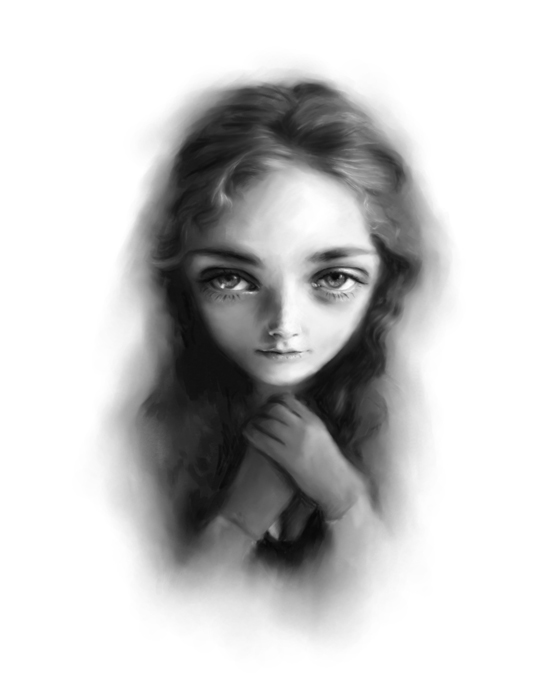
The beat of my heart, 2014. Charcoal and mixed media on paper.
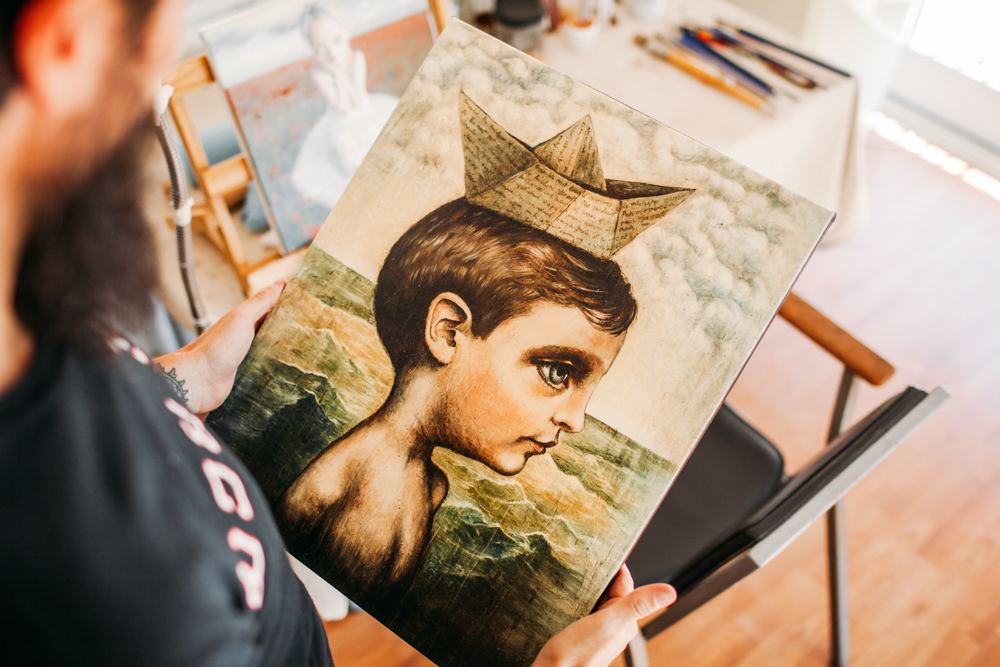
Can you tell us more about the giant you talked about carrying?
It’s not a personal giant, it’s metaphorical. What we tend to do is we have our life, which is the experience now through our senses, and then we have our life story, which is our identity from the past and our projected future which only happens in the existing mind. What tends to happen is I see the life story as an alternative me. Your mind is useful, don’t get me wrong, it’s useful for planning things, your frontal lobe is amazing, that’s what separate us from the animals. We’re able to see the outcome, run it through our head, and then decide if we want to go though with this. It’s often wrong, extremely exaggerated, this is known.
The things that we think are going to make us happy sometimes don’t. The things that we think are going to be tragic are sometimes not. Our mind is a useful tool, obviously, in terms of clock time. But aside from that, when your mind controls you instead of you using your mind as a tool, that’s when you become immersed in the life story and that’s this ‘guy’ – I don’t name him – but it’s this other personality that you drag with you. Which is your identity and your ego and your projected future.
So I guess it’s that that I’m talking about. And wherever you go, if that’s with you and you’re not able to experience fully, then you kind of missed the point. Another way of looking at it is: I used to see life as I’m on a train and I’m heading this direction and when I arrive there, that’s going to be awesome. I don’t see it like that anymore. I’m actually here and I’m in the train and everything’s moving past me. I’ve got no way go, the arrow has moved from that direction to here. So I try to focus on everything not being things that I have to do, but these things that I do are opportunities in how to be. And when I say be, I focus on making the most of every circumstance and not seeing those [as] problems, [but as] just situations. Now is the only time I really exist, so it’s taken away that kind of ego clock-time-mind from owning me. I’ve actually gone behind that to an awareness. Metaphysics! [laughs].
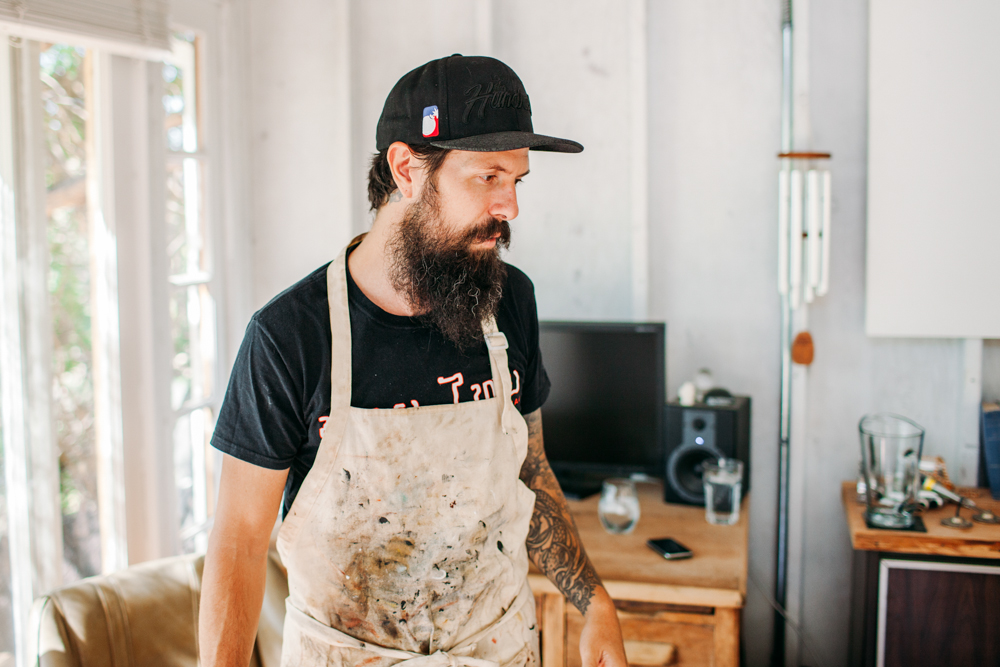
::
::
Richard J Oliver’s debut East Coast exhibition at New York’s Last Rites Gallery opens this Saturday, July 12th, from 7-11pm. The gallery is located at 325 W 38th St. #1, New York.
Keep up with Richard on his Instagram @richardjoliverfinearts.

